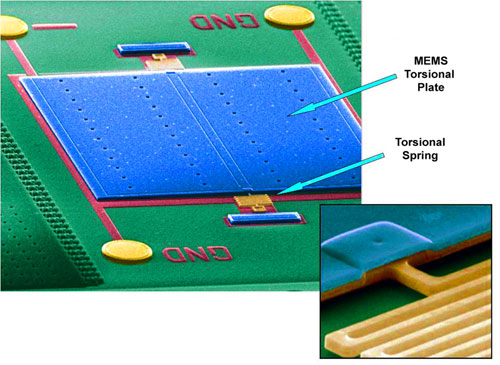|
|
| Scientists to Conquer Casimir Effect, Enable NEMS |
 |
Text Size: A A A |
|
If Argonne National Laboratory researchers are successful in their quest to nullify Casimir force effects, NEMS implementations will take off.
Alexander E. Braun, Senior Editor -- Semiconductor International, 1/19/2010
Scientists at the Argonne National Laboratory (ANL), are working to harness the Casimir Effect, a quantum mechanical force that attracts objects a few nanometers apart, posing a serious obstacle to the implementation of nanoelectromechanical systems (NEMS). NEMS could find unique applications in sensing, telecommunications, signal processing, data storage and more; however, at nanoscale levels the Casimir force is very strong, making it difficult to control these devices. Unless a way is found to do this, NEMS may never achieve their potential.
Predicted in 1948 by Dutch physicist Hendrik B.G. Casimir, the Casimir Effect results from the fact that space is filled with vacuum fluctuations, virtual particle-antiparticle pairs that continually form out of nothing then quickly vanish. This effect is observable between two metallic parallel plates placed 100 nm apart. The gap between the plates restricts the range of wavelengths possible for these virtual particles. With fewer of them present within that space this results in a lower energy density between the two plates than is present in open space. This creates negative energy and pressure that pulls the plates together; the narrower the gap, the more restricted virtual particles' wavelength, the more negative the energy and pressure, the stronger the attractive force. At nanoscale, it becomes the dominant force between uncharged conductors. Depending on surface geometry and other factors, at separations of 10 nm the Casimir Effect can produce the equivalent of 1 atmosphere of pressure (101.3 kPa).
 |
|
MEMS setup used to detect the presence of Casimir force. (Source: ANL) | According to Daniel Lopez, an Argonne scientist working on the project, from a technological perspective, the Casimir force is a problem, not an interesting effect. "When two mechanical objects come closer than 200 nm, the Casimir force becomes dominant. If you want to measure something, you have problems because the force is so huge at these scales that it can prevent you from doing anything else," he said. Lopez pointed out that researchers working on ion traps for quantum computers find that these ions are very close to the trap surface where the Casimir Effect becomes very important. "The force must be well-characterized if you wish to use ion traps for quantum computing; otherwise, the ions will go anywhere in the traps."
The researchers' goal is to do the most precise characterization of this force to learn exactly how material properties influence its function, which is important in trying to eliminate it. The Argonne group received a grant from the Defense Advanced Research Projects Agency (DARPA) to try to design mechanisms to control it. The Casimir Effect produces an attractive force. If it were possible to make it repulsive, it might be used to actuate NEMS devices. "This is an attractive option, because then you could use quantum mechanics to move nanoscale objects," Lopez said. "Perhaps it can be the energy source to move these tiny devices."
The research team has done a very detailed characterization of the Casimir Effect, and knows how component and materials' properties can influence it. There are several ways to do it. An option is surface nanostructuring — creating a pattern with dimensions ~50 nm thick — and using laser light to illuminate these structures to determine if it is possible to balance the force using some specific radiation pressure.
"Casimir's original experiment used two metallic parallel plates to localize photons between them," Lopez said. "Suppose we do nanopatterning on one of them. Now you have a uniform plate, but the other has an array of 50 nm thick lines that work somewhat like a diffraction grating, which may balance off the photons' attractive effect, considerably reducing the Casimir forcer. However, if the nanowires are thick enough to support some sort of plasmonic excitation, repulsion may result. We're trying to balance and control the number of photons between the plates, relative to the plasmons that can be induced by creating a surface pattern, to determine whether our repulsion calculations are correct and patterning can control the Casimir Effect."
A repulsive Casimir force is attractive because there is no way today to actuate NEMS devices in a controllable way; below 1 µm, matters get complicated because there are many fringe fields, heating effects and other complicated excitations that cannot be controlled. Some researchers think that this research might lead to levitation. "If you have a nanoscale repulsive force, you can levitate objects, separated by gaps of 100 nm or so. Friction could be reduced to almost zero," Lopez said, adding that so far this is speculation. "However, if friction is eliminated, the result is a very efficient device and energy savings."
Success in this endeavor could be of vital importance. Today, data-bearing light in fiber cables is controlled using tiny mirrors manipulated by an electrical field. But if the mirror's size continues to shrink, the electrical fields that control it must also be reduced. "Suppose you have a mirror 100 µm in diameter — a big MEMS device," Lopez said. "When you apply a 10-V voltage, it can be moved and controlled relatively well. A submicron mirror would be extremely difficult to control by using only electrostatic forces. Now you need new forces to control such devices. Part of the research is aimed at determining whether the Casimir force would be a good candidate for this type of application."
A decade ago, the Casimir Effect was an academic curiosity. Today, it is a technological problem, because if NEMS devices are to be used for thousands of applications, it becomes necessary to control the quantum forces that come into play at those scales.
Quantum mechanics is quickly becoming quantum engineering
|
|











